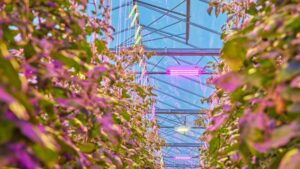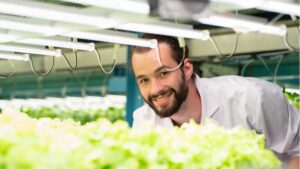
Greenhouse interior | Agri-Starts
Recently, our sister brand of Growing Produce (under the Meister Media Worldwide umbrella) and writer Ellie Gabel of Revolutionzed looked at innovations in the horticulture industry related to greenhouse seedling production. Here’s a look at what they had to say:
If you are in the horticulture industry, staying in touch with new seedling production methods is vital. Innovations are budding worldwide, literally and metaphorically. Promise the best environment for your greenhouse by learning how next-generation seedlings improve the sector and explore groundbreaking perspectives you can use in your operations.
Greenhouse-Grown Produce Drives Scalability Demand
Recent sustainability trends and cost-of-living increases have made people more aware of what’s in their shopping bags, turning them toward greenhouse-grown products. Their interest in locally grown produce has risen, prompting growers to adopt novel growing techniques to meet demand.
Inconsistent weather conditions and labor scarcity slow seedling production, driving growers to shift from outdoor growing techniques to nurseries. Simultaneously, mergers, acquisitions, and expansions are becoming increasingly frequent as interest in local products rises.
While greenhouse-grown produce has a high, consistent yield potential compared to outdoor techniques, scalability is vital. In other words, smaller horticulturists and floriculturists may have to adopt novel nursery technologies to keep up with the steadily increasing consumer demand while maintaining a competitive edge.
LED Greenhouse Climate Control
You can use light-emitting diode (LED) lighting to accelerate seedling growth while heating your greenhouse. The research paper “Heating Greenhouses by Light: A Novel Concept for Intensive Greenhouse Production”
hosted on ScienceDirect suggests you could secure an estimated 44% higher yield by exclusively using LEDs with a photosynthetic photon flux density of 450 micromoles per second per square meter for lighting and heating.
Since LEDs have a much higher photosynthetic photon efficacy than the traditional high-pressure sodium lamps you probably typically use, they’re ideal for greenhouses. Pairing them with thermal screens, ventilation cooling, a heat pump, and a dehumidifier lets you keep your space at the optimal temperature year-round.

Dynamic LED lighting | Signify
LED Light Spectrum Manipulation
According to the paper “LED Lighting to Produce High-Quality Ornamental Plants” hosted on MDPI, strategically selecting light spectrum components using LED lighting intentionally triggers plant development, manipulating growth rates, flowering, stem length, and color to your benefit. For example, blue, red, and far-red spectral wavelengths affect ornamental plants’ decorative aspects.
Light-Shifting Greenhouse Films
Even with energy-efficient lighting, greenhouses use a tremendous amount of power. However, with novel lighting technology purpose-built for traditional greenhouses, you can manipulate natural light for electricity-free growth manipulation.
Researchers filled a film with quantum dots — nanoscale crystal screens and monitors used to emit color — to shift the UV light spectrum from blue to red. This technique passively makes sunlight color more consistent and intense, accelerating growth, improving yields, and saving energy. It helped growers increase tomato size by 20% in one real-world test, according to Fast Company.
Smart Hydroponics Systems
Smart technology can automate hydroponics management by measuring parameters like pH, temperature, and humidity, and reacting accordingly. With a greenhouse-wide system and a graphical user interface, you can remotely check every metric at a glance.

Vertical growing | CEAg World
This novel technique can accelerate germination and growth. While hydroponics already reduces water consumption by up to 90%, according to the paper “Hydroponics: Current Trends in Sustainable Crop Production” hosted on the National Center for Biotechnology Information, compared to traditional soil-based growing, the resource savings automated systems provide add up over time.
Smart greenhouse technologies like automated hydroponics systems minimize the amount of in-person monitoring necessary. They can even reduce maintenance costs by a fraction, according to the paper “Automated Smart Hydroponics System Using Internet of Things” hosted by Core.
Kenyan Sowing Trays
Kenyan floriculturists are challenging traditional outdoor sowing methods. You prevent germination problems by sowing seedlings in trays instead. Growers do this before taking them to other farming locations.
Each tray contains holes for whatever material the seedling grows best. They are recyclable, stackable, and easy to clean, permitting multiple uses. You water the trays as normal, but seedlings are more likely to succeed here because no wind or sun can harm them.

Seed germination trays | Metrolina
You can adjust shade as necessary, controlling every aspect of the growing environment. Tests show a 98% germination rate in the trays, and people using this method say it’s more effective than nurseries. They also conserve water and other resources like planting mediums as room for trial and error reduces.
This doesn’t mean nurseries are inefficient in expanding seedling production. Experienced growers can innovate in these environments for optimal output, too. One case study documented by Nifty Hoops demonstrates how a nursery overcame challenges by installing shade cloths and caterpillar tunnels, among other inventions. These provide greater control over more fickle elements of nursery production.
Food For Thought
Your greenhouse’s future relies on modern thinking. Urban sprawl and natural disasters demand yield increases and regenerating habitats. Greenhouses and other controlled growing environments are critical pillars for this shift.
Disruptive techniques strive to regulate growth for consistency and productivity. Designing these technologies and growing methods requires careful consideration of the climate crisis. Fortunately, balancing every metric and influence is possible with collaboration and evidence-based decision-making.
The original article can be found on the Growing Produce website, along with more news coverage for specialty crop growers.

